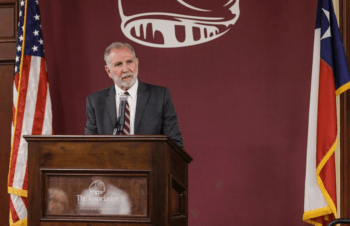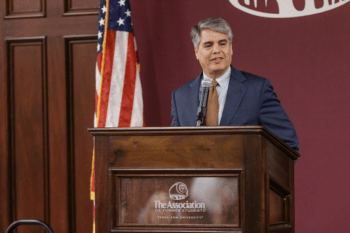Texas A&M-UT Leaders Address Issues Of Diversity And Inclusion
Texas A&M University and the University of Texas at Austin may not be in the same athletic conference anymore, but one thing they still share is the challenge of maintaining a welcoming campus climate for diversity and inclusion.
Texas A&M University and the University of Texas at Austin may not be in the same athletic conference anymore, but one thing they still share is the challenge of maintaining a welcoming campus climate for diversity and inclusion. Faculty and administrators from both universities met at Texas A&M this week to discuss the successes they’ve seen and the challenges they face in creating equity and inclusion in higher education.
John Sharp, Chancellor of The Texas A&M University System, was among the speakers Monday at the annual joint meeting of the Texas A&M Faculty Senate and The University of Texas at Austin Faculty Council, titled “Successes and Challenges to Maintaining a Welcoming Climate for Diversity and Inclusion: A Conversation with Aggie and Longhorn Faculty Senators.”

In introducing the meeting’s keynote speaker, Texas A&M System Regent William Mahomes, a 1969 Texas A&M graduate and the first African-American to start as a freshman and graduate from Texas A&M as a member of the Corps of Cadets, Sharp said, “He is a testament to the power of quiet confidence, commitment, compassion, courage and clarity of purpose. He is a life-long barrier-breaker, a pioneer, and has distinguished himself through dozens of trailblazing firsts.”
Mahomes discussed the challenges of growing up in Texas as an African-American during segregation and attending Texas A&M at a time when many on campus were resistant to integration. “I was surprised by the resistance and the attitudes of many of the people here,” Mahomes said. “Not to say they were all bad, but there were some who were not what I thought they should be.”
He addressed a recent incident on the Texas A&M campus in which a racial slur was directed to a group of visiting students. “Fifty years after desegregation, students should not still be facing the same barriers I faced in 1965. As unfortunate as it was, it was a wake-up call for us in terms of how to handle those situations,” he noted, adding he was pleased with the prompt condemnation of the behavior by the university president and system chancellor.
He also noted the response of the student body, particularly the massive letter-writing campaign organized by Aggie students to express their apologies. “I have never been more proud of our student body,” he stated.
Texas A&M President Michael K. Young also addressed attendees, saying campus climate issues are about more than just respect and tolerance. “It is about creating opportunity for every student, and every faculty and staff member to grow, develop and thrive. This is about deep engagement, collaboration and understanding.”

Young noted that at Texas A&M, “We address great global challenges – clean water, health of people, animals and the environment, energy. All of these are socioeconomic issues. If you live in a fancy suburb in Dallas or Seattle or Salt Lake City, you are drinking clean water. But if you live in Flint, Michigan or on a Native-American reservation, water may be a problem. So if we are really trying to address global challenges, but we don’t think about socioeconomic factors, our impact as a university will be significantly minimized.”
Universities must teach students how to get along in an increasingly diverse world, Young concluded, saying, “It is a profound responsibility for universities; if we don’t address it, who will?”
In his presentation, UT-Austin President Gregory L. Fenves reflected on last summer’s controversy about statues on the UT campus depicting leaders of the Confederacy. “My office overlooked a statue of Jefferson Davis,” he noted. “What is the symbolism of that?”
Fenves said he heard many opinions on both sides of the issue, but in the end it was decided to move the statues to a museum, “to allow them to remain as a way to interpret history, understand its historical context and use it as a basis to move forward.”

He also noted agreement with President Young regarding the responsibility of higher educators to promote multicultural understanding. “Change and improvement in society has to take place at universities; students must be prepared to lead in a diverse world.”
Both Young and Fenves were making their first appearances at the joint meeting of the two faculty senates. The senators are elected by their fellow faculty members and share in the governance process for their respective universities.
The meetings rotate between the College Station and Austin campuses and, in addition to addressing issues of mutual concern, provides networking and related opportunities for the faculties of the two universities.
In addition to hearing remarks by the two presidents and the keynote address by Regent Mahomes, the senators held a session regarding Title IX and another titled “Universities as Federal Contractors: Obligations, Challenges & Opportunities.”
Later this week Texas A&M faculty will join students and staff for another opportunity to engage in open dialogue about issues related to diversity and inclusion at the Campus Climate Conference, Wednesday and Thursday at the Memorial Student Center.
For more information visit http://campusclimate.tamu.edu/.
